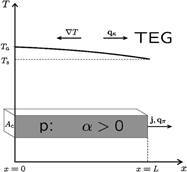Article contents
Performance optimization of a thermoelectric generator element with linear, spatial material profiles in a one-dimensional setup
Published online by Cambridge University Press: 29 June 2011
Abstract

Graded and segmented thermoelectric elements are studied in order to improve the performance of thermogenerators that are exposed to a large temperature difference. The linear thermodynamics of irreversible processes is extended by assuming spatially dependent material parameters like the Seebeck coefficient, the electrical and thermal conductivities. For the particular case in which these transport coefficients exhibit a constant gradient, we present an analytical solution of the one-dimensional thermal energy balance in terms of Bessel functions. Given linear spatial material profiles, we discuss the optimization of performance parameters like the electrical power Pel and the efficiency η of a graded thermogenerator element of fixed length and fixed boundary temperatures. The results are compared with the constant properties model, i.e., physically and chemically homogeneous material, as a suitable reference for performance evaluation.
Keywords
- Type
- Articles
- Information
- Journal of Materials Research , Volume 26 , Issue 15: Focus Issue: Advances in Thermoelectric Materials , 14 August 2011 , pp. 1963 - 1974
- Copyright
- Copyright © Materials Research Society 2011
References
REFERENCES
- 11
- Cited by


